Index


Review: Old dog learns new tricks
XFX has launched a special Radeon R9 280X with non-reference cooling and it’s called "XFX DOUBLE DISSIPATION RADEON R9 280X 1000MHZ BOOST 2GB DDR5 GHOST2 THERMAL DUAL MINI DISPLAYPORT HDMI DUAL DVI or Part No.: R9-280X-TDFD". Of course, we won’t use the official name in the rest of our review for obvious reasons.
The R9 280X is part of the latest AMD generation of graphics cards known under the Volcanic Islands codename, but it’s not exactly new. The new portfolio of Volcanic Islands graphics cards consists of the Radeon R9 280X, R9 270X, R7 260X, R7 250X and R7 240, and two more yet to arrive are Radeon R9 290X and R9 290. Of course, other Pro versions are probably in the works.
This time AMD decided not to launch the fastest cards first, opposite to what we saw with the two previous generations. What many of you already know, all the “new” cards with exception of the R9 290X and R290 are actually rebranded, retweaked and newly priced products from the current HD 7000 series.
Following the new naming scheme the Radeon R9 280X was previously known as the HD 7970 GHz Edition. Because the same Tahiti GPU is on both cards performance difference between the R9 280X and the HD 7970 GHz Edition will be insignificant.
AMD’s new naming scheme is not all that great, but it’s also not hard to understand and remember. If you spot R9 within the card name it will tell you this is an enthusiast grade product, and the R7 prefix denotes a mainstream product.
Note regarding the R9 enthusiast grade products are yet to come and the R9 290X and R9 290 will be only and truly new enthusiast graphics cards based on the new Hawaii GPU.
However, the HD 7970 earned a rock solid reputation for being great for gaming and relatively light on your credit card. We believe gamers will continue to adore the R9 280X due to its attractive price point. Both the R9 280X and HD 7970 GHz Edition are now available for about 280 euro. However note that the HD 7000 cards are getting some interesting discounts, so some better deals may be available.
AMD gained plenty of attention with its various gaming bundles, but unfortunately we have some bad news for gamers who are still keen on the Never Settle voucher program, which includes three free games. AMD decided, at least for now, not to include the game voucher with R9/R7 series graphics cards. We are confident that with this marketing the stock of HD 7000 cards is soon to be emptied.
So, XFX is also playing the no-Never-Settle-voucher game, but at least it has made some important design changes to the PCB and came up with a new cooler, thus making its Radeon DD R9 280X 1000M card very attractive. 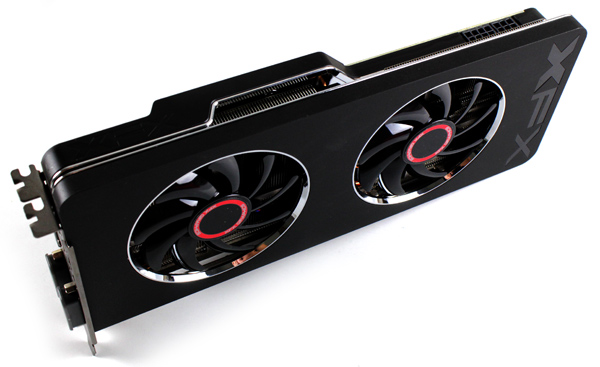
The R9 280X is based on the 28nm Tahiti core (4.3 billion transistors) which features 32 compute units and 2048 stream processors based on Graphics Core Next (GCN) architecture. Next to that we have 32 raster operation units (ROPs), 128 texture memory units (TMUs) and six 64-bit memory controllers meaning 384-bit memory interface connected to GDDR5 memory. All in all we have exactly the same set of components presented in the Radeon HD 7970 GHz Edition. DirectX 11.2 is supported along with OpenGL 4.3 and AMDs own new low level programming interface known as Mantle (which is also supported on all AMD cards with GCN).
XFX Radeon DD R9 280X 1000M runs at reference clocks. This set the GPU clock at 1000MHz while GDDR Memory ticks at 1500MHz (6000MHz effectively).The R9 280X card is strapped with 3GB of GDDR5 memory, which will be of much use to gamers running at resolutions above 1920x1080.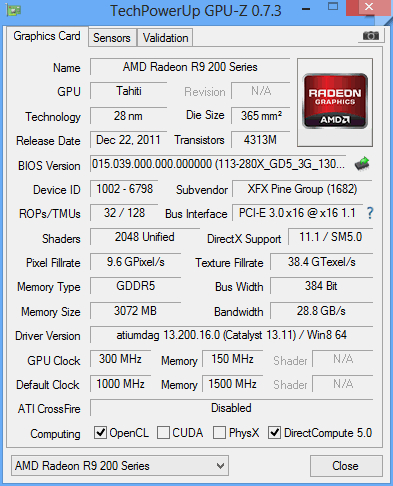
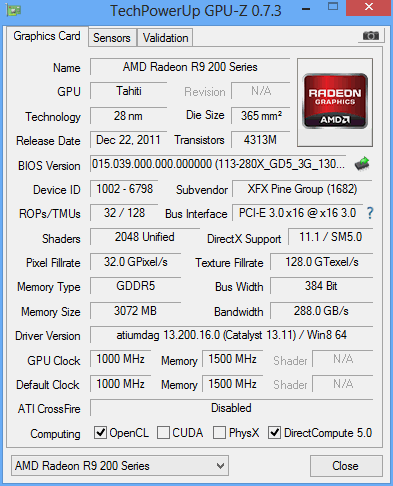
During its latest event AMD also announced the new TrueAudio feature. This should allow hardware-accelerated audio processing in the GPU, but developers have to code its games and applications to support TrueAudio and not all older cards will support it. There are three upcoming games, Thief, Murdered and Lichdom with support for the TrueAudio. With the ability to process over a hundred independent audio streams in real time alongside with the game or application processing it will be possible to incorporate great audio effects e.g., positional data to audio sources.
Sadly, the fact that only GPUs based on the upcoming Hawaii chip or on the Bonaire chip can use TrueAudio. This means from the whole range of current graphics cards only the HD 7790 and R7 260X (both based on the Bonaire core) support TrueAudio.
R9 280X does not come with TrueAudio, but due to lack of games or apps created with support for the TrueAudio we do not really care at the moment. However lack of the TrueAudio can be seen as drawback in the future, but who knows, it might not be relevant in this card’s product cycle. It all depends on developer support.
The packaging for the R9 280X 1000M has the same dimensions as the rest of XFX’s HD 7000/6000/5000 offer – it is small and sturdy. However the visual appearance is now changed more the way of being classic old school design, which is good.
In the box you’ll find:
User Guide
Quick Installation Guide
Driver DVD
Driver/CD Install Guide
1x molex to 6-pin Power Adapter
1x 6-pin to 8-pin Power Adapter
CrossFire Bridge
and some promotional material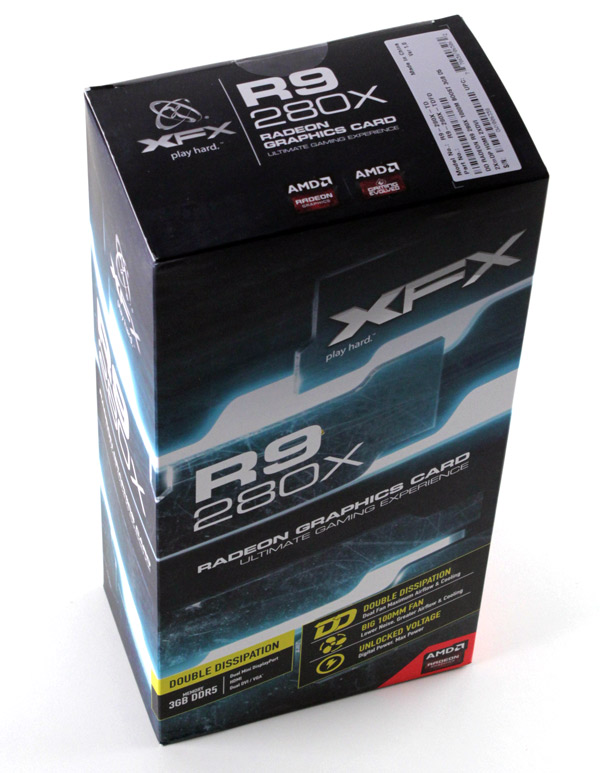
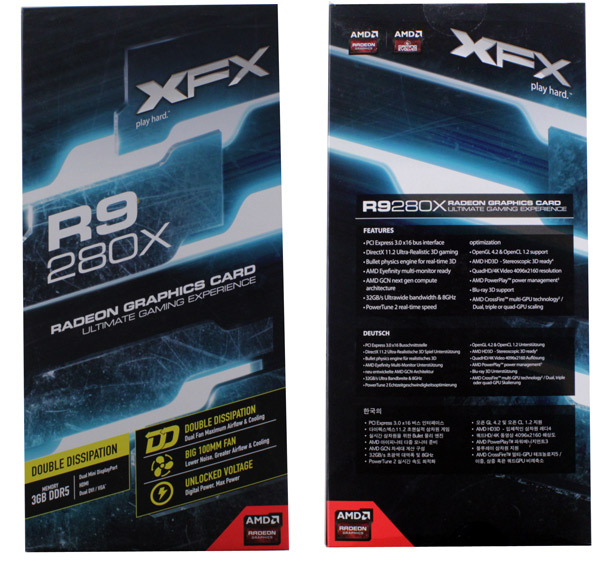



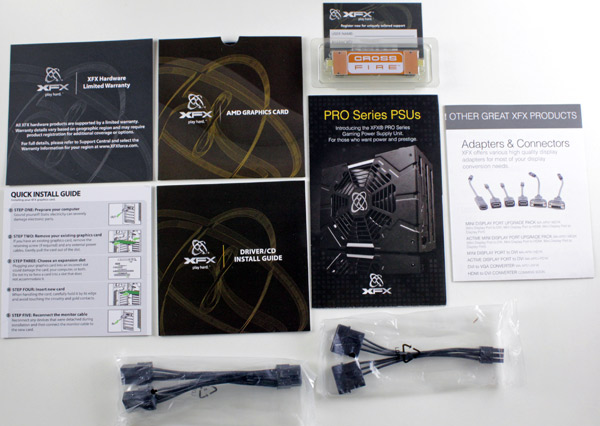
In order to deal with a relatively hot GPU, the card comes with a powerful second-generation Double Dissipation cooler – a cooler with a special heatsink and two fans. When we heard that XFX is working on a new cooler we could not wait to give it a go in our bench rig. Why? Because AMD's own cooling solution for the R9 280X did not end up as quiet as we all hoped it would be.
Just to refresh your memory, XFX was among first to hit the market with a non-reference HD 7970 graphics card. The card featured high factory overclock but thanks to Ghost Thermal Technology and XFX's first-generation Double Dissipation cooler, GPU thermals were kept in check and on top of that our ears were threated more gently compared to the reference cooler. The Double Dissipation cooler on the HD 7970 managed to provide good cooling while keeping noise levels at a reasonable level; it was not completely silent but it was close. However standards have now changed and users simply demand quieter coolers. This has a lot to do with Nvidia, which really raised the bar with its latest generation reference coolers and the Titan cooler in particular.
AMD managed to create a new reference cooler for Volcanic Islands which is significantly quieter compared to the previous generation, but as we already noted it is not silent. However it looks like all AMD partners have decided to implement in-house designed coolers for the R9 280X and we will not see reference cards in the shops.
XFX also has its own cooler which design borrows from the reference one only in that it takes a small amount of AMD’s traditional red color to create nice diverging effect for the fans and the cooler is two slots high.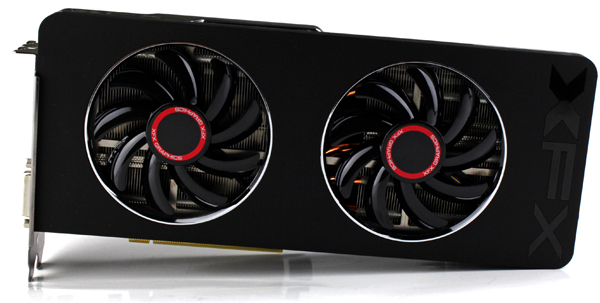
Ghost 2.0 Thermal design is the key factor for better cooling performance and it is a substantial design evolution from the original Ghost thermal design introduced in 2012. XFX opted for this technology because it allows airflow to cool the heatsink as well as other components on the PCB. As you know, overheated components and even an overheated PCB can also reduce performance. The new design includes a bigger dissipation surface, which is achieved by extending the cooler's height one and half centimeters over the standard size.
The Radeon DD R9 280X 1000M draws power via a 6-pin power connector and another 8-pin power connector. You will find a 6-pin to 8-pin power converter in the package.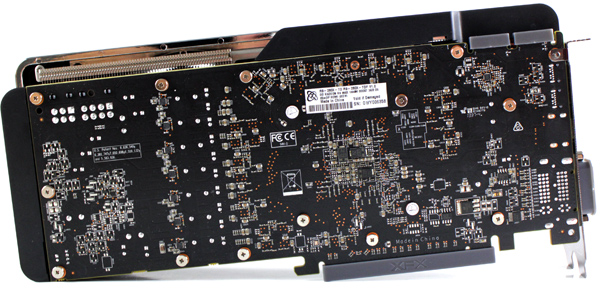
Because the cooler’s size extends over the standard size XFX decided to use lightweight polycarbonate construction which also ensures high durability and heat resistance. A new two-piece design protects PCB components from damage and dust and results in a beautiful, modern industrial design. The shroud house two IP5X Dust Free 85mm low profile fans. XFX opted for two fans that push air downwards, straight at the heatsink. As a result, some of the heat may be released inside the case so you might want to make sure your in-case airflow is adequate.
Both fans share the same 4-pin power connector. Setting the RPM manually is a breeze using AMD’s Overdrive or any other popular utility like MSI Afterburner or PrecisionX.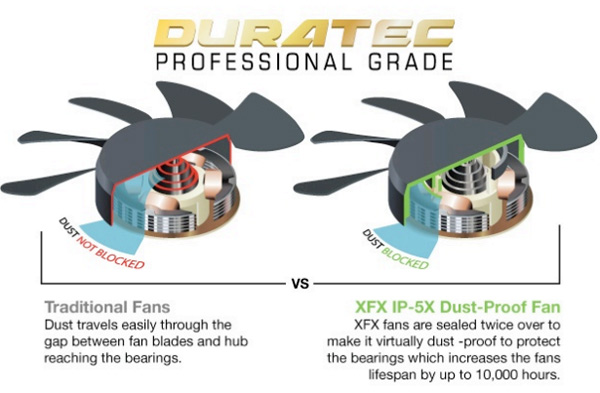

The card has two dual-link DVI outs, one standard HDMI and two mini DisplayPort outs. Next generation 4K (4096x2160) and UHD (3840x2160) resolutions are supported. You can also combine any combination of display connectors. 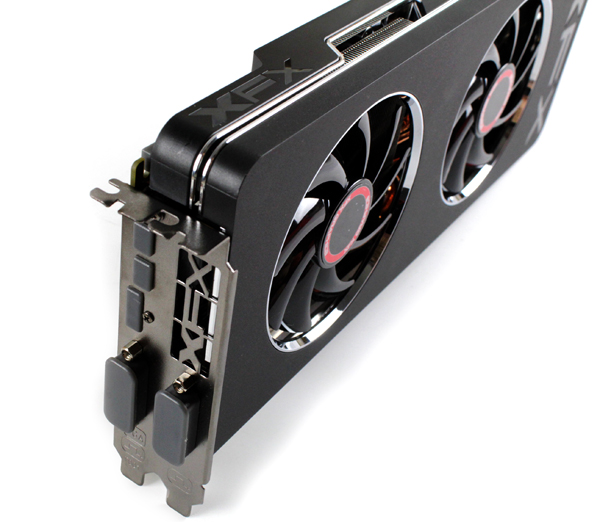
The bracket design includes the XFX logo which actually helps increase airflow, however it is not very important for the Double Dissipation cooler because this cooler features an open cooling design.
The card comes with two CrossFire connectors and it is possible to combine it with the old HD 7970. Actually you can use any combination of HD 7970 / HD 7970 GHz Edition / R9 280X cards.

On the next pictures you can see how the Radeon DD R9 280X 1000M manages heat dissipation. The cooler is held in place with four screws only, but we didn’t notice any instability or vibration. If you decide to take off a cooler from the PCB, it will void the warranty. Sadly, the rear of the PCB features no backplate, which is not important for the performance but would make overall design much more visually appealing.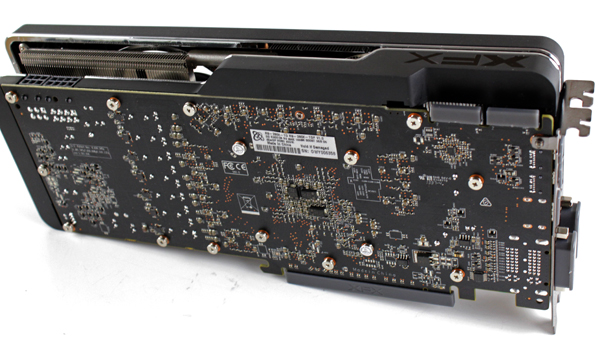
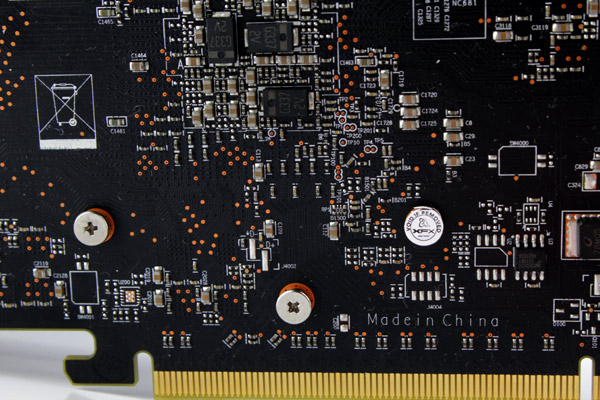
The PCB length is 26.7cm while the card with the cooler measures 28.4cm. Aside from the GPU, the fans are in charge of cooling hot components on the PCB too. 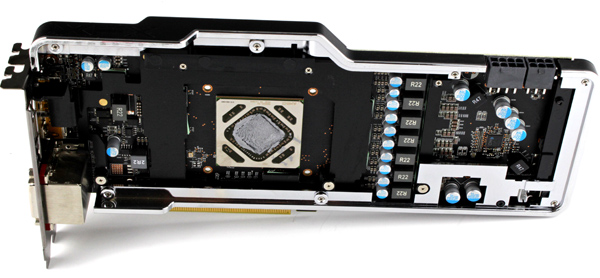
XFX decided to use the baseplate to strengthen the PCB and provide better cooling for the memory chips and MOSFET. All the memory modules at the front of the PCB are tucked away underneath the reinforcement plate. XFX used high quality components such as solid capacitors and ferrite core chokes.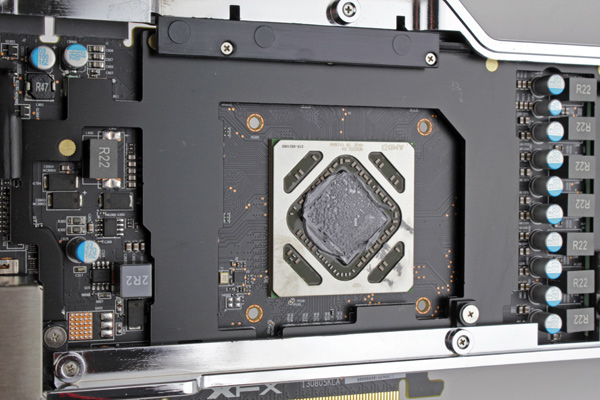
XFX DD R9 280X 1000M is equipped with extra power phase IC's thus going up from the standard 5 to 6 phase power setup. With this card, XFX is reaching out to overclockers, too, by unlocking voltages. It is advised not to go over 1.256V for the Asic (default voltage is 1.144V).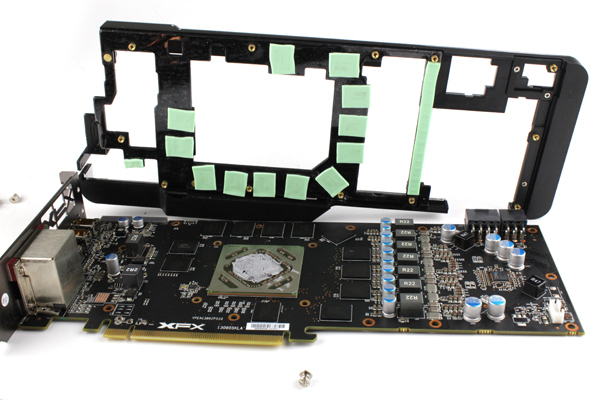
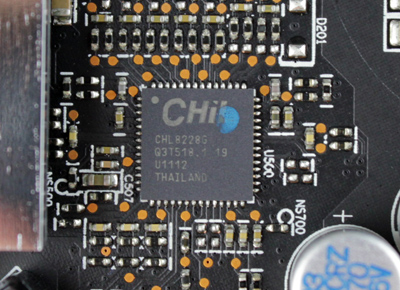
The GDDR5 memory chips are made by Elpida and they are specified to run at 1500 MHz (6000 MHz GDDR5 effective).
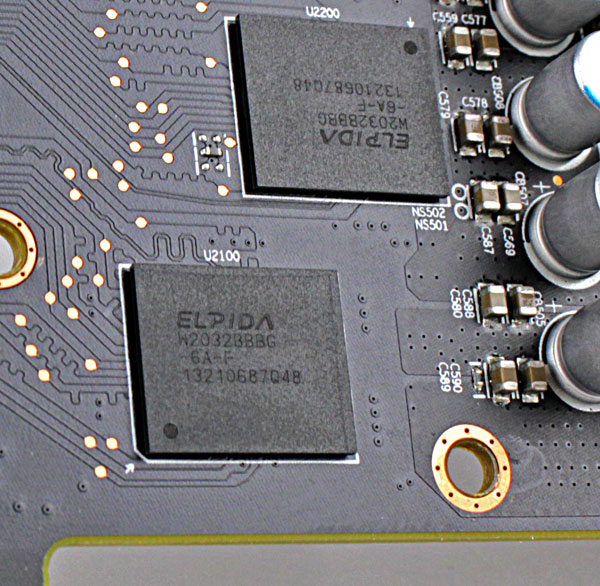
The new Double Dissipation cooler uses six heat pipes and Fin-Grid arrays of heat dissipaters, all of which are strategically custom positioned to ensure the most effective and efficient cooling working in unison with the evolved fans. The 6mm heatpipes are curved so they don’t protrude from the cooler at any point.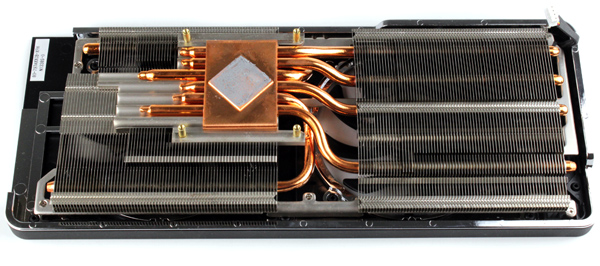
The welds between the heatpipes and aluminum fins are accurate and look like they’ve been done very well indeed.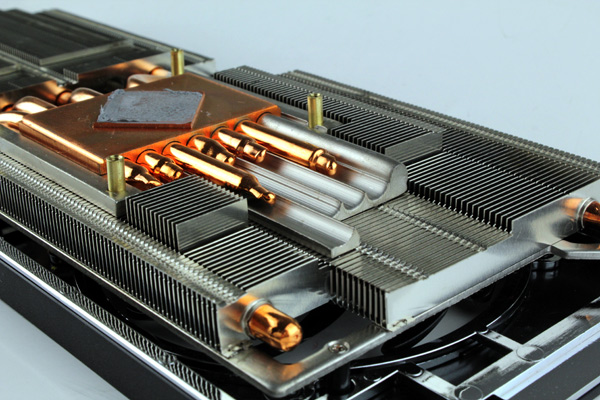
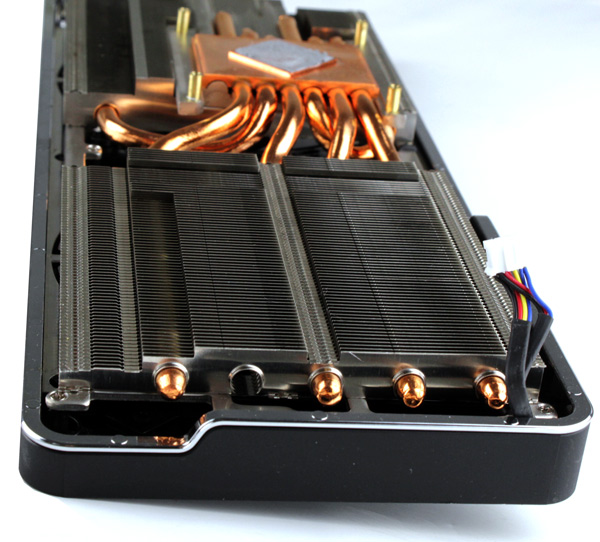
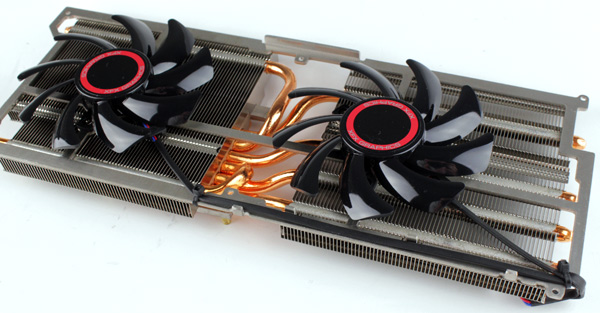
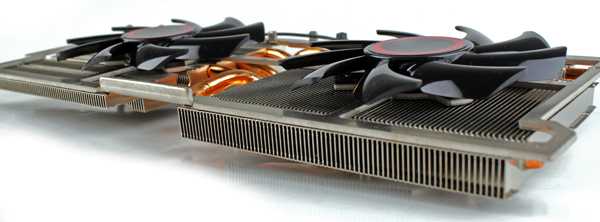
Testbed:
- Motherboard: Intel DZ87KLT75K
- CPU: Haswell (Socket 1150) Core i7 4770K (3.5GHz)
- CPU Cooler: Cooler Master
- Memory: 16GB Patriot PC3-128000H DDR3 1600MHz
- Harddisk: Corsair Neutron GTX 240GB
- Power Supply: CoolerMaster V-Series 1000W
- Case: CoolerMaster Cosmos II Ultra Tower
- Operating System: Win8 64-bit
Drivers:
- Nvidia 331.40 (beta)
- AMD 13.11_betaVI
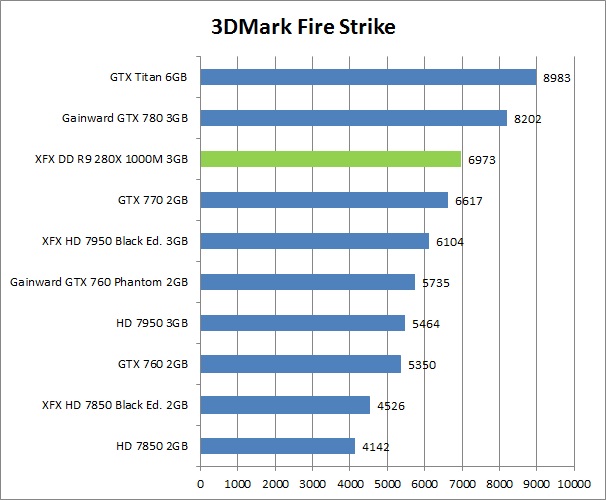
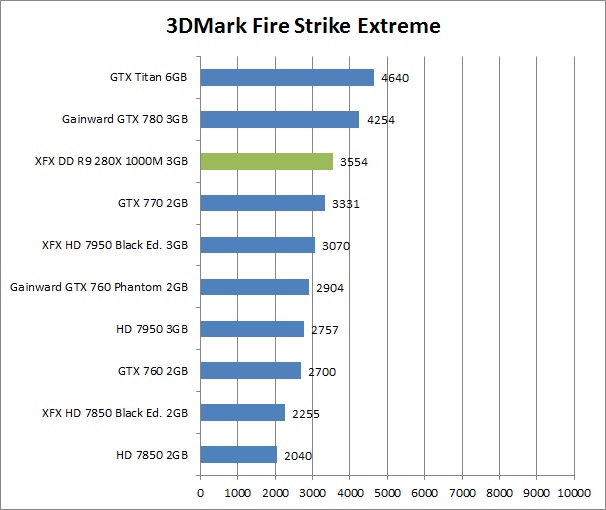
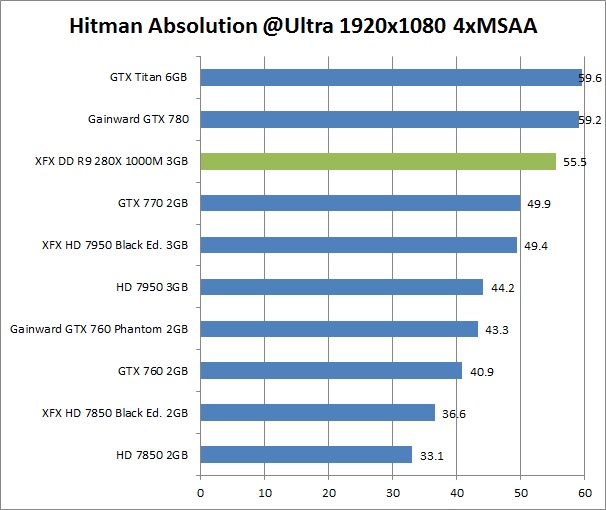
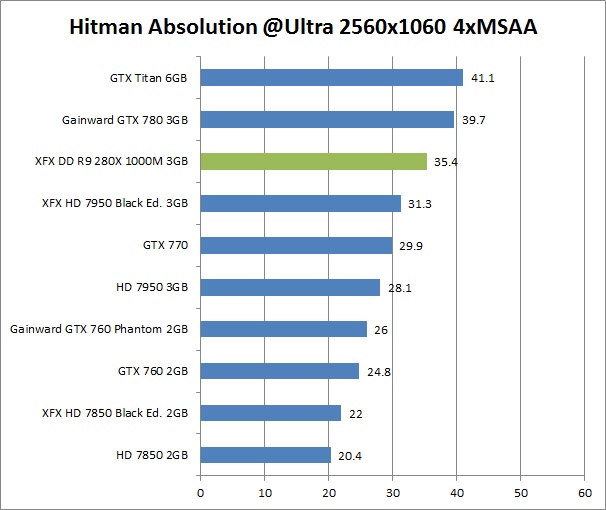
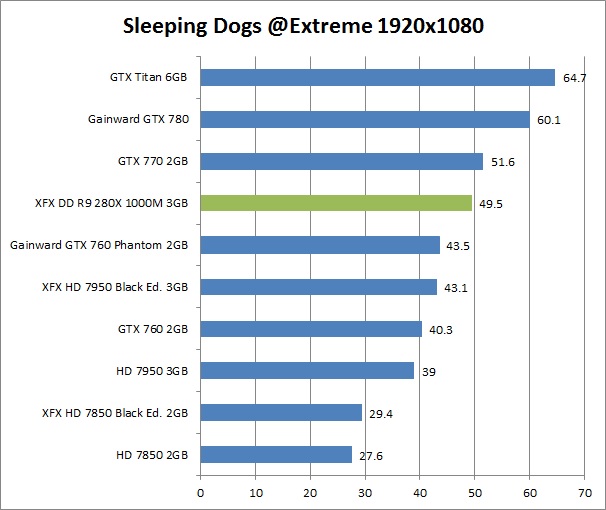

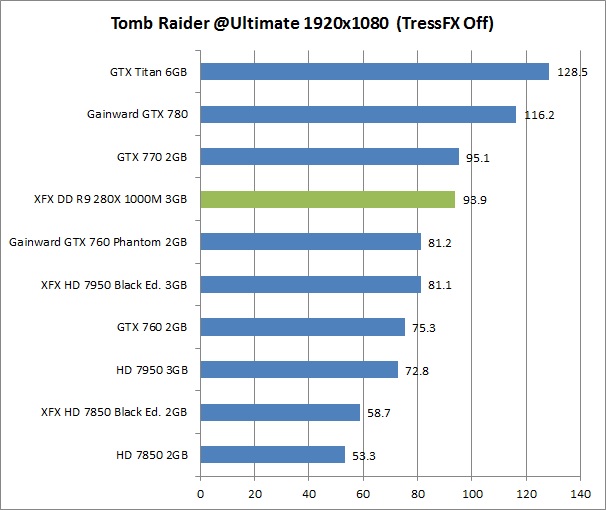

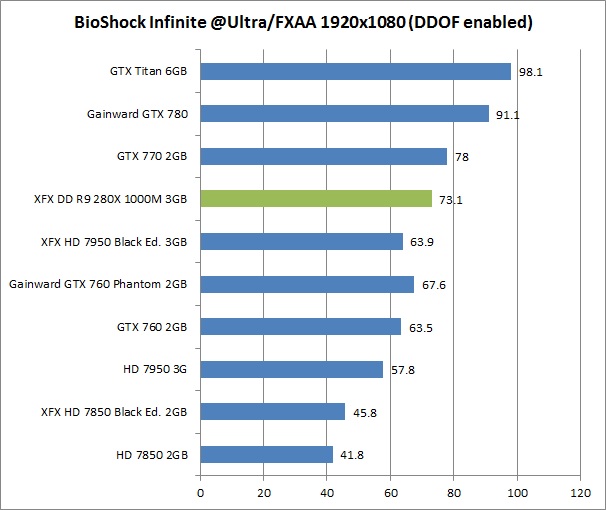

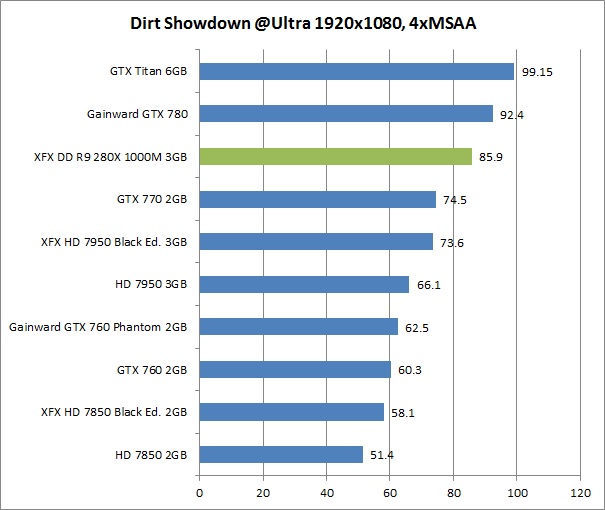
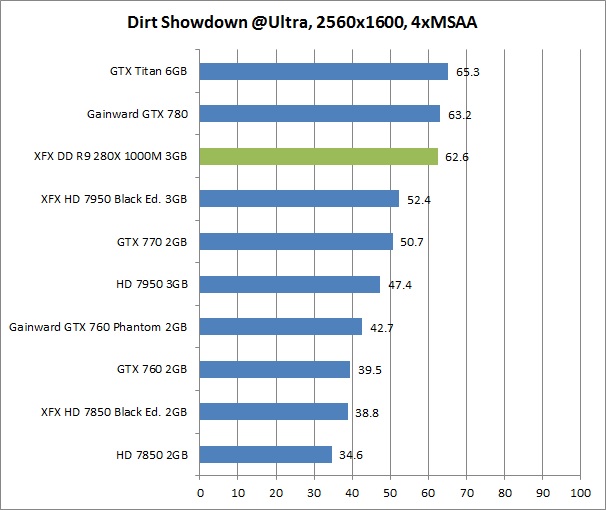
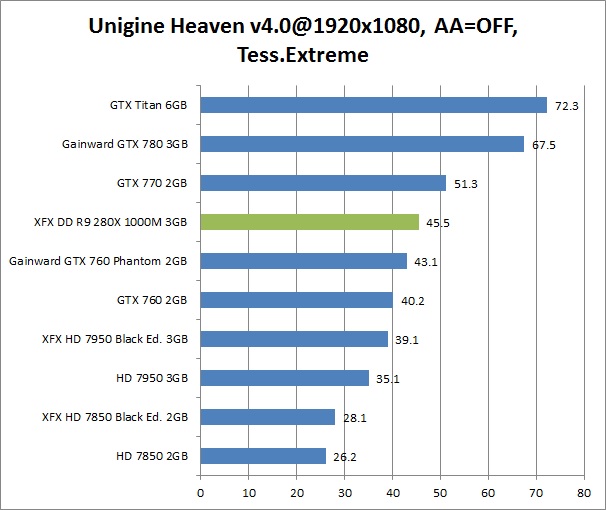
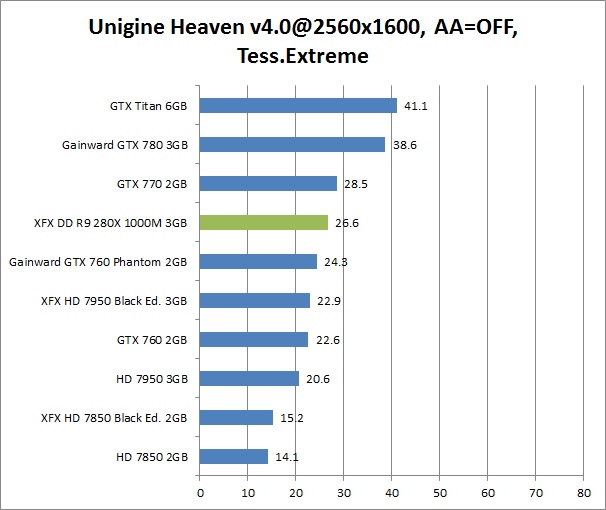
XFX’s new Double Dissipation cooler does a great job and manages to keep noise very low. We could hear the fans under load but they were anything but loud. The DD R9 280X 1000M is quieter than the GTX 770 and it’s much quieter than the old HD 7970. We did not notice any sudden fan speed fluctuations, either. The GPU temperature goes up to 72 degrees Celsius during intensive gaminig and that is great taking into consideration the relatively low amount of noise.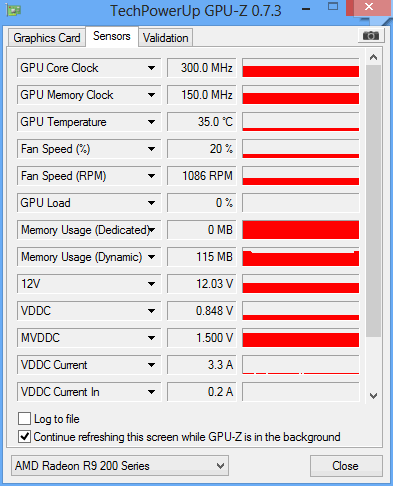

The XFX DD R9 280X M1000 card is reference clocked, meaning 1000MHz for the GPU and 1500MHz (6000MHz effectively) for the memory. Most buyers probably won’t feel the need to overclock the card, as it already has enough muscle to cope with current generation games, provided the resolution isn’t too high.
However, there are those who will overclock it for fun, or just to show off, in which case it’s what we call overcocking rather than overclocking. Still, there are a number of gamers who might need a bit more performance, at 1440p or 1600p.
In any case XFX did a clever thing by unlocking the voltages and allowing users to squeeze out more performance. The Double Dissipation cooler comes in handy if overclocking is what you’re after. It does its job very well on reference clocks and cooling an overclocked GPU is not an issue for this cooler either.
On stock voltages we were able to achieve only average overclocking results. It could be simply that we were not lucky and we got the GPU which was not willing to work on higher frequencies. However, we then decided to play around with the voltages and after a slight increase we got much better results. MSI’s Afterburner tool (version 3.0 beta 15) works with the DD R9 280X 1000M and allows users to change GPU/memory voltages with relative ease
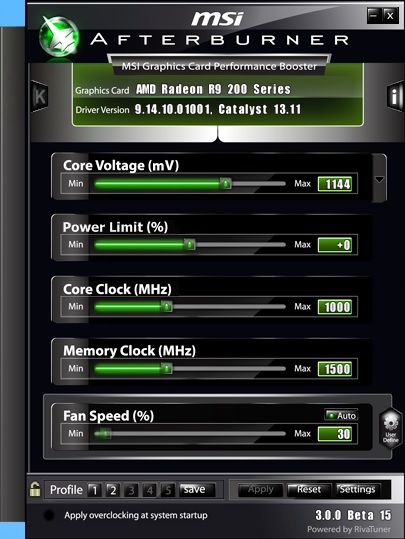
Without a voltage increase (default 1144mV) we achieved 1065MHz on the GPU but after the voltage increase to 1256mV we scored 1150MHz. We achieved a memory nice overclock of 20 percent (from 6000MHz to 7200MHz) without increasing the voltage.
XFX actually has two bios versions for the card. The second bios, which is practically the overclocking bios, will be available online and it will allow users to flash the bios from Windows or DOS. With the so-called OC bios we managed to get marginally lower results compared to our first run, in which we adjusted the voltages manually, using Afterburner. However, we also noticed a few side effects, such as increased power draw and higher GPU temperature.
With the default bios on reference clocks the GPU voltage does not go over 1.18V.

The OC bios went to 1.25V, even on reference clocks. At the same time the GPU was hotter and the fans were a bit louder.
On the other hand, the OC bios allowed us to boost the clock by 130MHz, while the default bios ran out of steam at 65MHz. We are of course talking about stable clocks, but in some games we could go up to 30MHz higher.
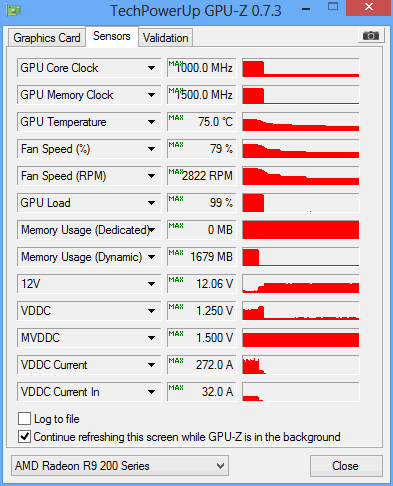
Low GPU overclocking headroom could be the reason XFX is binning GPUs and keeping the better ones for Black Edition cards.
Power consumption is a little bit lower compared to the HD 7970 GHz Edition cards. However we do not see no significant improvements over the previous generation.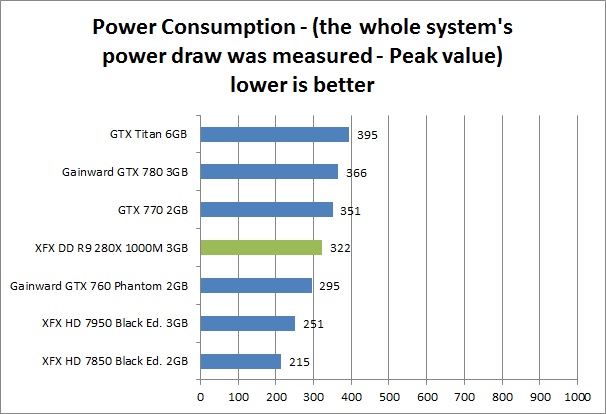
It is not secret that the Radeon R9 280X is actually a renamed Radeon HD 7970 GHz Edition card. Its performance is clear proof that the cards are practically identical. Of course, the price cannot be different, either.
Both cards are currently available for about 280 euro or 299 dollars, but this will change very soon, mainly because the stock of HD 7000 generation cards will not last long, especially when consumers realize that they’re not going to get Never Settle freebies with R9 cards.
Right now the HD 7970 GHz Edition looks like a better choice because we can find some good deals and it also includes Never Settle vouchers for three free games. The Never Settle voucher is currently not available for the new R9/R7 series graphics cards but we suspect this will change as HD 7000 inventory is depleted.
Although the GPU hasn’t changed, XFX did a pretty good job at making its new 280X special. First of all we must admit that DD R280X 1000M is one of the best looking dual-fan graphics cards we’ve seen so far and on top of that it is one of the quietest HD 7970/R9 280X – it might be the quietest, but we still haven’t tried out enough 280X cards to be sure. The icing on the cake is great cooling performance, as we measured only 72 Celsius degree for the GPU.
There’s no reason to waste much time commenting performance. We are all already aware of what the old HD 7970 GHz Edition was capable of and the R9 280X is more or less the same card. Gaming at high resolutions is not a problem, not even in some of the most demanding titles out there.
The card is reference clocked, but the overclocking potential is not among best we have seen. With a voltage increase we achieved an additional 150MHz for the GPU, which isn’t bad, but it’s still not very good, either. Memory overclocking was much better.
If you have HD 7970/ HD 7970 GHz Edtion and you want more performance you can use the R9 280X in CrossFireX mode.
In conclusion, we liked the Radeon DD R280X 1000M, mainly thanks to its great cooler. Overclocking headroom may be limited, but a very quiet cooler that does a great job keeping the GPU and PCB chilled is something we always appreciate. Great cooling also helps longevity and keeps components from dying, so we’re not surprised to see XFX offering a lifetime warranty on Double Dissipation cards. The price is relatively attractive as well. It’s currently available for about €280, but once more retailers start carrying it we could see some even lower prices. Bear in mind that Never Settle freebies are still not available with Rx200 cards, but AMD told us that bundles will be back.



